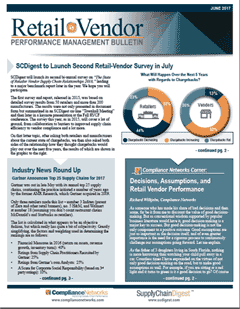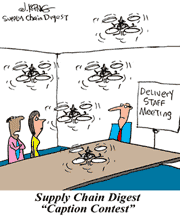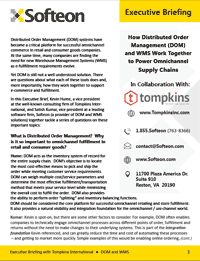 |
July 13, 2017 - Supply Chain Flagship Newsletter |
 |
| FEATURED BULLETIN |
|||
| The Retail Vendor Performance Management Bulletin |
|||
June 2017 Issue:
• Decisions, Assumptions, and Retail Vendor Performance • TJ Maxx Sourcing Practices Questioned |
|||
 |
|
||||||||||||||||||||||||||||||||||||||||||||||||||||||||||||||||||||||||||||||||||||||||||||||||||||||||||||||||||||
|
|||||||||||||||||||||||||||||||||||||||||||||||||||||||||||||||||||||||||||||||||||||||||||||||||||||||||||||||||||||
|
|||||||||||||||||||||||||||||||||||||||||||||||||||||||||||||||||||||||||||||||||||||||||||||||||||||||||||||||||||||
|
|||||||||||||||||||||||||||||||||||||||||||||||||||||||||||||||||||||||||||||||||||||||||||||||||||||||||||||||||||||
|
|
|
YOUR FEEDBACK
Some more of the many emails we received on SCDigest Editor Dan Gilmore's column on Irrational Shipping Prices and the Demise of Brick and Mortar Retail and Reader Respond - Irrational Shipping Prices and the Demise of Brick and Mortar Retail.
Feedback on Irrational Shipping Prices and the Demise of Brick and Mortar Retail Parts 1 and 2
![]()
Another great discussion. Keep up the great work of tabling interesting issues like this!
I am surprised that no one has highlighted the cost-to-serve differential.
There is a common upstream sourcing organization that ensures available supply that can serve any downstream demand, so we can consider that cost neutral.
From the consumer's perspective, there are store replenishment costs that will include replenishment, inventory planning, order (and payment) processing, picking, packing & shipping, freight, delivery, store shelf replenishment, cashier, store supplies and maintenance, return, and distressed sales costs, as well as the fixed costs of rental, utilities, insurance, security and so on. These can be performed in an organized and productive way, with use of consolidation techniques that drive marginal costs down. If ecommerce operates out of retail stores, the efulfillment costs come in addition to the store costs above. This cost model is clearly higher than the classic retail go to the store and shop. I guess many retailers adopted it so they could offer ecommerce without disorganizing their bulk-optimized facilities or creating green-field operations with the ensuing fixed costs. I hope theses operations were never intended to be as profitable as the store itself, which is a high fixed cost model.
Where things get complicated is when there is an efulfillment operation that is optimized for piece picks and appropriately automated, with effective delivery route optimization. It seems obvious that this is a more expensive operating model than the pure retail setup as shipment volumes are simply smaller, delivery is less dense, and operations are more difficult to predict and therefore plan. But they are a largely proportional to volume.
So the crux of the cost discussion comes down to break even points between the two operating models. The largest cost element is delivery freight, or the last mile. Hence the discussion about who pays the true cost of delivery.
I think the convenience of piece picking and home delivery has value and that it must be remunerated (it costs you tie and expense to do it yourself), so ecommerce orders should capture a higher price. I remain baffled by the ecommerce business model end game. In the meantime, enjoy the battle at the margins where you can obtain superior value for money - as long as it lasts.
On another but related thought, I read recently that ecommerce deliveries are sucking up all the traffic congestion gains that were obtained through the massive tolls charged to enter downtown London (UK) - average speeds are lower than before the toll was introduced, even though the car traffic has fallen as expected. So there are also hidden costs to the ecommerce model that we have yet to understand.
Nick Seiersen
![]()
I sell a fair amount of items on EBAY as a "Top-Rated Seller". While we do enjoy some discounts from FedEx and the USPS, they are nowhere near what a large online retailer would receive. In fact, the recent price increases from all of them (UPS as well) in my opinion, can only be attributed to the growth of Amazon.
If you have to keep upgrading your delivery infrastructure (trucks, DC's, drivers, warehouse workers) and you cannot raise your prices on your biggest customer, you have to fund it somehow. That falls on the back of everyone else. Of course, everybody expects free shipping, so any price increase comes right out of your pocket.
Gary Hemmingstad

![]()
The dot-com bubble was heavily fueled by customer acquisition at all costs. Since then, Amazon and others have been acquiring customers at a lesser cost and that investment/cash flow has sustained, enabling them to slowly and steadily habitualize customers to e-commerce shopping. Bolstered by convenience as well, the tactic has worked and slowly web-only players are growing their profits. Help from carriers in the form of discounts also makes the strategy possible.
One day however, when physical retail is damaged enough, the market conditions allow it and the desire for bigger profits is vocal enough, "free shipping" is certain to be reflected in pricing that exhibits the true costs of e-commerce. A good measure of this can be gleaned today: Amazon is quite often not the lowest-priced vendor for many goods, even with shipping factored in, but with their dominant market position they make it work. It's a telling sign for the future, especially the future of "free shipping."
Ken Lonyai

![]()
What is important is for today's retailer to compete online — and to market and emphasize to customers that they have click and collect capabilities. Going omnichannel and promoting it vigorously means more customers will pick up in-store, which cuts shipping costs. As online is pressured into increasing order sizes for free shipping, or is forced to charge for shipping, the opportunity for omnichannel retail will grow.|
Omnichannel retailers are just NOT promoting their
in-store pickup services enough. There is a big opportunity to both cut costs and to grow sales as in-store pickups result in around 59% more purchases.
Actually charging for what it cost to pick, pack and ship will be a boon for brick-and-mortar, and omnichannel retail is the way thrive.
Charles Dimov
Director of Marketing
OrderDynamics

SUPPLY CHAIN TRIVIA ANSWER
Q: Nancy Nix was just announced as the 2017 CSCMP's Distinguished Service Award winner for 2017. How many other women have received the DSA?
A: Just one, Ann Drake of DSC Logistics in 2012.
| © SupplyChainDigest™ 2003-2017. All Rights Reserved. SupplyChainDigest PO Box 714 Springboro, Ohio 45066 |
POWERED BY: XDIMENSION
|








